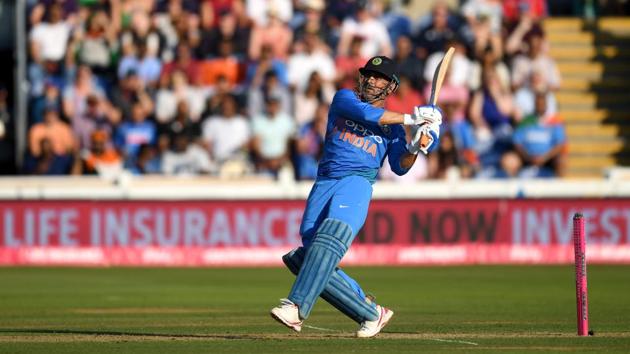MS Dhoni retirement: End of an epoch in Indian cricket
Dhoni made this announcement via an Instagram post on Saturday, a day that marked India’s Independence Day, with the following message.
Nearly 400 days since he played his last match for India, Mahendra Singh Dhoni has retired from international cricket, putting to an end both a storied career and months of speculation on his future. Dhoni made this announcement via an Instagram post on Saturday, a day that marked India’s Independence Day, with the following message.

“Thanks a lot for ur love and support throughout from 1929 hrs consider me as Retired,” the caption of the post read, which also contained a slideshow of images from his dazzling decade-and-a-half spell with the Indian cricket team, which he championed in several roles—as India’s most illustrious captain, distinguished wicketkeeper and also as one of the most destructive batsmen the world has ever seen.
Also read: MS Dhoni: Tinker, Tailor, Soldier, Bye
The career, then, began and ended with a run out. On December 23, 2004, a 23-year-old boy with a bleached mane was run out first ball during his debut match in Chattogram against hosts Bangladesh, ostensibly desperate to score his first international run. And on July 9, 2019—a day after he turned 38—Dhoni fell short of the crease in Manchester while attempting to take a second run against New Zealand in the semifinal of the World Cup. His score of 50 was unable to take India over the line, and as he walked back to the pavilion—disappointment stretched over his grizzled face—the whispers about his impending retirement had turned into a raging national debate.
In between that shaky start and end, Dhoni’s storyline had the mythical narrative of a Bollywood movie (of which one has indeed been made). He had a cricket-crazy nation starved of consistent success eating out of his hands, first with the bat, then with his gloves and most definitively with his leadership. He also transcended the game, becoming a cultural icon, an emblem of small-town India making it to the top of the world.
Also read: MS Dhoni Test, ODI and T20I runs, highest score, average, strike rate, catches and stumpings
A blazing 148 in Visakhapatnam against Pakistan in just his fifth ODI made him both a household name and the country’s first-choice wicketkeeper. That hundred was scored while batting at No.3, just as his second ton (which also happens to be his highest ODI score of 183*) scored a year later was. But very soon he would establish himself as a middle-order batsman of such repute that Dhoni was recognised as the greatest finisher in the game, so much so that India was never beyond posting a grand total or chasing down an impossible target until Dhoni had had his say.
In 2007, Dhoni’s first leadership test was at the inaugural T20 World Cup in South Africa. With Indian cricket’s behemoths—Sachin Tendulkar, Sourav Ganguly and then-captain Rahul Dravid—sitting out of the team in an untested format, Dhoni led India’s new-gen to his first of three ICC majors with a win against Pakistan in the final at Johannesburg. This he did by tossing the ball towards Joginder Sharma—a small-time bowler from a small town that no one had heard of— against a raging Misbah ul Haq, and his captaincy skills were never questioned again.
The timing of that trophy ensured that India was gripped with the fever of T20 cricket, serendipitously in time for the Indian Premier League in 2008. As the star-captain of Chennai Super Kings, Dhoni set the marker for franchise cricket greatness by leading his team to the IPL final in eight out of the 12 seasons so far. CSK won three times.
Also read: Tributes pour in as MS Dhoni calls time on international career
By 2008, Dhoni was captain of all three formats with the Indian team. Under his stewardship, and with a little help from coach Gary Kirsten, Dhoni dragged India to No.1 in the world in Test cricket for the first ever time in their history. This ranking was achieved with a drawn series in South Africa in 2011, making Dhoni the only Indian captain to have not lost a series on those shores.
While the Test mace was symbolic of Dhoni’s influence on a side that was fractured into unhappy factions right through the first decade of this century, Dhoni’s finest hour as both captain and batsman, undoubtedly, came at the 50-over World Cup that the subcontinent hosted in 2011. In the final against Sri Lanka at the Wankhede Stadium in Mumbai, Dhoni’s steely nerves burdened the weight of a tricky chase with 91 unbeaten runs, ending a 28-year wait for glory with a six that’ll perhaps always be entwined with his legacy.
That legacy, however, was stained somewhat in the lead up to his sudden Test retirement in the middle of a Test series in Australia in 2014, possibly brought upon by several consecutive away series losses, including whitewashes in England and Australia, just after the World Cup win.
Also read: ‘His leadership will be hard to match’: Sourav Ganguly pays tribute to MS Dhoni
Even after his Test retirement, Dhoni stayed on as India’s ODI captain until after the 2015 World Cup, completing his set of all ICC majors with a Champions Trophy victory in England (2013) along the way. Even as his fabled finishing touch abandoned him and his form in front of the stumps dipped drastically, Dhoni remained a constant in short-format cricket; partly due to his quick reflexes behind the stumps and mostly due to his ability to hand-hold new captain Virat Kohli.
Dhoni was picked in Kohli’s 2019 World Cup squad, despite having scored his last international century in 2017. The debate over his presence raged on during the course of the World Cup, and for a few months after. The uncertainty over his future had all but hijacked his narrative. Until Saturday, that is, when he exited the global stage far more quietly than he had first exploded onto it.






